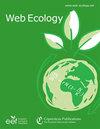本地生物多样性对四种葡萄品种损失的影响:生物抗性假说的检验
IF 2.4
3区 环境科学与生态学
Q2 ECOLOGY
引用次数: 1
摘要
摘要农业景观的管理可以影响生物多样性和这些生态系统提供的生态服务,如自然生物虫害防治。在大多数地中海气候的国家,葡萄种植是一项非常重要的经济活动,经常塑造他们的景观和文化。葡萄生产受到许多病虫害的影响,农民使用预防性和反应驱动型农药来控制这些害虫。本研究量化了4个葡萄等级作物损失的主要生物原因,2个红葡萄等级(Touriga Nacional和Baga)和2个白葡萄等级(Arinto和Chardonnay),并评估了本地生物多样性对害虫爆发和葡萄损失提供生物抗性的潜在影响。具体来说,对这些葡萄园中鸟类和昆虫群落的多样性和丰度进行了量化,并将其划分为功能行会(有害、中性或辅助),以测试这些自然群落在正常的葡萄园管理(包括施用农药)下是否具有自然控制葡萄害虫的潜力(生物抗性假设)。与葡萄园边缘的距离和葡萄损失之间的潜在联系也进行了评估。我们记录到葡萄损失的比例很小(平均= 0.6%;max = 7.5%),害虫表现出对巴加(红色)和霞多丽(白色)种姓的偏好,而鸟类害虫则避开了阿林托(白色)种姓。葡萄的颜色对虫害造成的损失没有影响,但鸟类表现出对红色等级的偏好。巴加种姓也更容易受到真菌造成的损失。尽管它们对葡萄生产的影响很小,但在六个葡萄园中检测到的大多数昆虫和鸟类都是害虫,这在这个高度管理的农业生态系统中意味着潜在的低水平生物抗性。进一步的研究是必要的,以充分评估功能生物多样性在葡萄园中的作用,特别是如果替代生产过程,如有机农业,可以增加本地生物多样性的潜力,以防止在较低的化学喷洒制度下由害虫造成的葡萄损失。本文章由计算机程序翻译,如有差异,请以英文原文为准。
Effects of native biodiversity on grape loss of four castes: testing the biotic resistance hypothesis
Abstract. Management of agricultural landscapes can influence the biodiversity and the ecological services provided by these ecosystems, such as natural biological pest control. Viticulture is a very important economic activity in most countries with Mediterranean climate, often shaping their landscapes and culture. Grape production is affected by a number of pests and diseases, and farmers use prophylactic and response-driven pesticides to control these pests. Here we quantified the main biotic causes of crop losses in four grape castes, two red (Touriga Nacional and Baga) and two white (Arinto and Chardonnay), and evaluated the potential effect of native biodiversity to provide biotic resistance to pest outbreaks and grape losses. Specifically, the diversity and abundance of bird and insect communities in these vineyards were quantified and divided into functional guilds (pest, neutral or auxiliary), to test whether these natural communities hold the potential to naturally control grape pests (biotic resistance hypothesis) under normal vineyard management (including pesticide application regimes). A potential association between distance to the vineyard edge and grape losses was also evaluated. We recorded a very small proportion of grape losses (mean = 0.6 %; max = 7.5 %), with insect pests showing a preference for the castes Baga (red) and Chardonnay (white), while bird pests avoided the caste Arinto (white). Grape color did not influence losses caused by insect pests, but birds showed a preference for red castes. The caste Baga was also more vulnerable to losses caused by fungi. Despite their low impact on grape production, most insects and birds detected in the six vineyards were pests, which entails a potentially low level of biotic resistance in this highly managed agricultural ecosystem. Further research is necessary to fully evaluate the role of functional biodiversity in vineyards, particularly if alternative production processes, such as organic farming, can increase the potential of native biodiversity to protect against grape losses from pests under lower regimes of chemical spraying.
求助全文
通过发布文献求助,成功后即可免费获取论文全文。
去求助
来源期刊

Web Ecology
Agricultural and Biological Sciences-Ecology, Evolution, Behavior and Systematics
CiteScore
4.60
自引率
0.00%
发文量
6
审稿时长
17 weeks
期刊介绍:
Web Ecology (WE) is an open-access journal issued by the European Ecological Federation (EEF) representing the ecological societies within Europe and associated members. Its special value is to serve as a publication forum for national ecological societies that do not maintain their own society journal. Web Ecology publishes papers from all fields of ecology without any geographic restriction. It is a forum to communicate results of experimental, theoretical, and descriptive studies of general interest to an international audience. Original contributions, short communications, and reviews on ecological research on all kinds of organisms and ecosystems are welcome as well as papers that express emerging ideas and concepts with a sound scientific background.
 求助内容:
求助内容: 应助结果提醒方式:
应助结果提醒方式:


